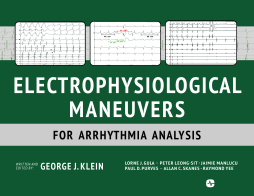
BOOK
Electrophysiological Maneuvers for Arrhythmia Analysis
George Klein | Lorne Gula | Peter Leong-Sit
(2014)
Additional Information
Book Details
Abstract
• From senior electrophysiologist and world-class educator George Klein, a fully illustrated guide with over 100 intracardiac tracings and figures that allow the physician to approach electrophysiologic problems effectively and systematically.
• The book is especially focused on electrophysiological maneuvers and provides a clear and understandable guide to their proper selection and interpretation using abundant clinical examples.
• Defines the integral role for "traditional" electrogram (EGM) analysis in order to understand the mechanism of a tachycardia.
It goes without saying that a correct arrhythmia diagnosis is a prerequisite to catheter ablation regardless of the presence of sophisticated mapping and imaging technologies. Electrophysiological maneuvers are fundamental to this process, and proper selection and interpretation of maneuvers constitute a core skill of the electrophysiologist. In this volume, we make the case that most maneuvers are fundamentally similar in principle and can be understood by appreciating a few basic physiological and anatomical principles. The art lies not in a comprehensive knowledge by rote of every maneuver or its application, but rather a systematic approach using common principles. We illustrate this by showing abundant examples and emphasizing the "game plan," including checklists that can be applied to virtually any maneuver.
—George J. Klein
In my opinion, this book should be on the shelf of every electrophysiologist trainee as well as every clinical cardiac electrophysiologist. It is a classic, like its editor. Dr. Klein deserves high praise for organizing his and his colleagues’ clinical experiences and thought processes into a concise, practical text that should be part of all training programs in electrophysiology.
—From the foreword by Mark E. Josephson, MD This book comprehensively discusses the principles behind electrophysiology studies. The importance of understanding cardiac anatomy, the physiology behind the maneuvers, the study of arrhythmias, and the benefits as well as the shortcomings of specific maneuvers are well elucidated. -Doody Revew (Saima Karim, DO)
Table of Contents
| Section Title | Page | Action | Price |
|---|---|---|---|
| Cover | i | ||
| Title Page | iii | ||
| Copyright | iv | ||
| Contents | v | ||
| Contributors | vii | ||
| Foreword | ix | ||
| Preface | xi | ||
| Abbreviations | xiii | ||
| Chapter 1: Principles of the EP Maneuver | 1 | ||
| The Importance of “Geography” | 3 | ||
| Fusion and Reset: A Key Concept | 5 | ||
| The Relationship between the His Refractory PVC during Supraventricular Tachycardia(SVT) and Entrainment of SVT from the Ventricle | 13 | ||
| Suggested Readings | 19 | ||
| Chapter 2: Maneuvers during Sinus or Paced Rhythm | 21 | ||
| Para-Hisian Pacing | 25 | ||
| Assessing a Line of Block | 40 | ||
| Assessing a Line of Block: Tricuspid-Caval Isthmus | 42 | ||
| Assessing a Line of Block: Left Atrial Roof Line | 45 | ||
| Assessing a Line of Block: Mitral Isthmus Line | 51 | ||
| Verifying PV Isolation | 57 | ||
| Mapping Gaps in Conduction | 60 | ||
| Differential Pacing to Identify Near- vs. Far-Field EGMs | 64 | ||
| Challenges Confirming Exit Block from the PV | 70 | ||
| Suggested Readings | 73 | ||
| Chapter 3: Extrastimuli during Tachycardia | 75 | ||
| Relationship of Extrastimuli to Entrainment | 76 | ||
| Diagnostic Utility of Programmed PVC, PAC: Specific Examples | 80 | ||
| Suggested Readings | 112 | ||
| Chapter 4: Overdrive Pacing and Entrainment: SVT | 113 | ||
| Avoidance of Common Mistakes: The Entrainment Checklist | 114 | ||
| Practical Usage of Overdrive Pacing/Entrainment | 116 | ||
| Suggested Readings | 136 | ||
| Chapter 5: Overdrive Pacing and Entrainment: VT, AF and Flutter | 137 | ||
| Ventricular Tachycardia | 139 | ||
| Atrial Tachycardia | 160 | ||
| Suggested Readings | 170 | ||
| Chapter 6: Nonstimulation Based Maneuvers | 171 | ||
| Isoproterenol | 172 | ||
| Adenosine | 173 | ||
| Confirming Existence of a Tachycardia Substrate | 174 | ||
| Wide QRS Complex Tachycardia Diagnosis | 177 | ||
| SVT Responses to Adenosine | 180 | ||
| Differentiating AVNRT from JT | 188 | ||
| Adenosine and Recovery of Conduction | 190 | ||
| Miscellaneous Nonpacing Maneuvers | 192 | ||
| Suggested Readings | 192 | ||
| Index | 193 | ||
| Back Cover | 197 |
